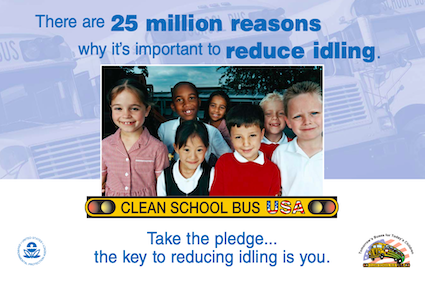Electric school buses: healthier air and zero vehicle emissions. (Photo source)
The Symbolic School Bus:
Ever since the 1940s, the yellow school bus has become synonymous with American schools (Pritchett, 2021). With its bright, distinct color and loud, revving engine, these buses are easily recognizable. However, with over 26 million students riding the school bus each day, the yellow bus can pose a threat to the environment and health of students (“Hop on the Bus”, 2009).
Implications of Diesel:
Diesel school buses have serious impacts on the environment. According to OEHHA (2003), diesel particulates cause acid rain, “which affects soil, lakes and streams and enters the human food chain via water, produce, meat, and fish.” Also, these emissions contribute to ground-level ozone damaging vegetation and crops. Not to mention, diesel exhaust is one of the leading causes of climate change and global warming. Black carbon particulates, a main component of diesel exhaust, are 3,200 times more damaging to the climate than carbon dioxide (World Bank, 2014).
Besides the environmental impacts, diesel exhaust has serious implications on human health. According to the Center for Disease Control (1988), diesel exhaust is a “class one carcinogen” to humans. The average “benign” amount of diesel exhaust in the air is about 350 to 400 parts per million (ppm). But when diesel exhaust levels reach around 1,000 to 2,000 ppm, this poses a risk to human health. This constant exposure to harsh pollutants can increase one’s risk for lung cancer, cardiovascular disease, worsening asthma, and bronchitis (Green Teacher, 2019). According to the EPA (2003), children are more susceptible to diesel pollution than adults as children breathe in 50% more air per pound.
The Solutions:
What are solutions to combat the negative effects of diesel exhaust? One solution is to switch to an electric fleet. Electric school buses do NOT emit greenhouse gases! Electric buses require minimal maintenance, and can support a school’s environmental goals by lessening carbon emissions.
Electric School Bus by Lion Electric called the LionC
While switching towards an electric fleet may take time to research and investigate, a short term solution is to have a “No Idle” campaign. This campaign encourages drivers to turn off their engines as they wait in the pick up line. EPA’s Clean School Bus USA program provides background information and includes a “reduce idle” pledge for bus drivers and families.
EPA’s Pledge to Reduce Idling program provides lots of good resources.
The Benefits of Going Electric:
Electric school buses may seem more expensive with upfront costs ranging from $325,000 to $400,000 compared to diesel buses at $100,000 (Rosen, 2020). However, there are ways to earn money from an electric vehicle through its vehicle to grid (V2G) technology (Thomas, 2019). V2G allows the battery to be a mobile charging station that can either give or get electricity. It has bi-directional charging capabilities allowing electricity from the battery to be put back into the grid (“EV Technology,” 2013). Schools receive money for selling electricity back to the grid. Electric buses are programmed to take energy when it costs less and the demand is low (at night time) and then sell it back when it is more costly during peak times.
The second way schools earn money is through contracts with utility providers to sell back excess energy used when the demand is high. This is beneficial for utility providers because it helps with frequency and energy regulation. Electric buses are perfect for this because they sit idle for much of the day and have fixed routes. Not to mention, electric engines have lower maintenance and labor costs (Thomas).
Fast charging stations are the future!
Besides low maintenance costs, e-buses reduce noise pollution. The recommended safe noise level is anything less than 80 decibels; however, school buses produce levels of 85 decibels (“Benefits of Adding”, n.d.). Not to mention, electric school buses do not emit any exhaust. Electrifying a school’s fleet sets an example to the community by reducing their carbon footprint, promoting a healthier lifestyle, and incorporating tangible solutions. The opportunities and benefits from electric school buses outweigh diesel buses.
Invest in the Future:
Electric school buses provide a host of benefits from environment to social to health. They may seem like a large investment but with the revenue generated, subsidies, and grants offered, they are a no brainer. Taking the bus to school is an integral part of many students’ daily routine. What better way to start a child’s school day than by hopping on an electric bus?
Resources:
NewsWheel: “A Brief History of the School Bus,” by Morgan Pritchett, July 14, 2021
American School & University, “Hop on the Bus,” March 1, 2009
Green Teacher: “The Health Risks Posed by Diesel Bus Emissions,” by Green Teacher, April 30th, 2019
Herching Report: “The Route School Buses Can Take Toward Racial Equity,” by Andre Perry, June 19, 2018
OEHHA: “Health Effects of Diesel Exhaust,” May 21, 2001
New York Times: “Making Yellow School Buses a Little More Green,” by Ellen Rosen, Aug, 27, 2020
New York University “The Case for Electric Vehicles,” by Stephanie Thomas, 2019
VIRTA: “EV Charging Technology,” 2013
EPA: “Diesel Exhaust and School Bus Idling,”June, 2003
First Student: “Benefits of Adding Electric School Buses to Your Fleet”
Article by Hannah Riegel (Boston College ‘22), Sustainability Intern, majoring in Applied Psychology and minoring in Environmental Science, Boyer Sudduth Environmental Consultants
Article printed in PAISBOA’s Friday Flyer Vol. X, No. 16 - November 5, 2021






